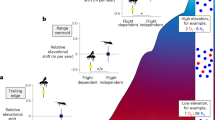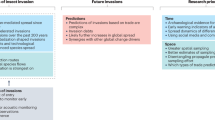Abstract
ENTOMOLOGISTS have long been aware that vast numbers of insects are distributed up to thousands of feet in the air on any warm day1. The men who collected evidence of this assumed that the insects were alive2–4. However, the trapping methods they used killed most of the insects so that mortality and viability could not be assessed. Other entomologists have been less confident of the vitality of insects dispersing regularly by such flights, perhaps because of a belief that an ascent to, say, 5,000 ft. means a flight of many hours; this is not necessarily so5. Nevertheless, it is not generally accepted that this mode of transport is no more lethal than flight near the ground6.
This is a preview of subscription content, access via your institution
Access options
Subscribe to this journal
Receive 51 print issues and online access
$199.00 per year
only $3.90 per issue
Buy this article
- Purchase on SpringerLink
- Instant access to full article PDF
Prices may be subject to local taxes which are calculated during checkout
Similar content being viewed by others
References
Johnson, C. G., Sci. Prog. Twent. Cent., 39, 41 (1951).
Glick, P. A., Tech. Bull. U.S. Dep. Agric. No. 673 (1939).
Hardy, A. C., and Milne, P. S., J. Anim. Ecol., 7, 199 (1938).
Johnson, C. G., J. Anim. Ecol., 26, 479 (1957).
Taylor, L. R., Proc. Linn. Soc., 169, 67 (1958).
Andrewartha, H. G., and Birch, L. C., “The Distribution and Abundance of Animals”, 109 (Chicago, 1954).
Johnson, C. G., and Taylor, L. R., Lab. Pract., 4, 235 (1955).
Author information
Authors and Affiliations
Rights and permissions
About this article
Cite this article
TAYLOR, L. Mortality and Viability of Insect Migrants High in the Air. Nature 186, 410 (1960). https://doi.org/10.1038/186410b0
Issue date:
DOI: https://doi.org/10.1038/186410b0



